Introduction
A single-flue chimney cap is a square or rectangular cover that bolts to the top of a masonry chimney with one terracotta flue tile. It keeps rain, animals, sparks, and downdrafts out while letting smoke vent freely.
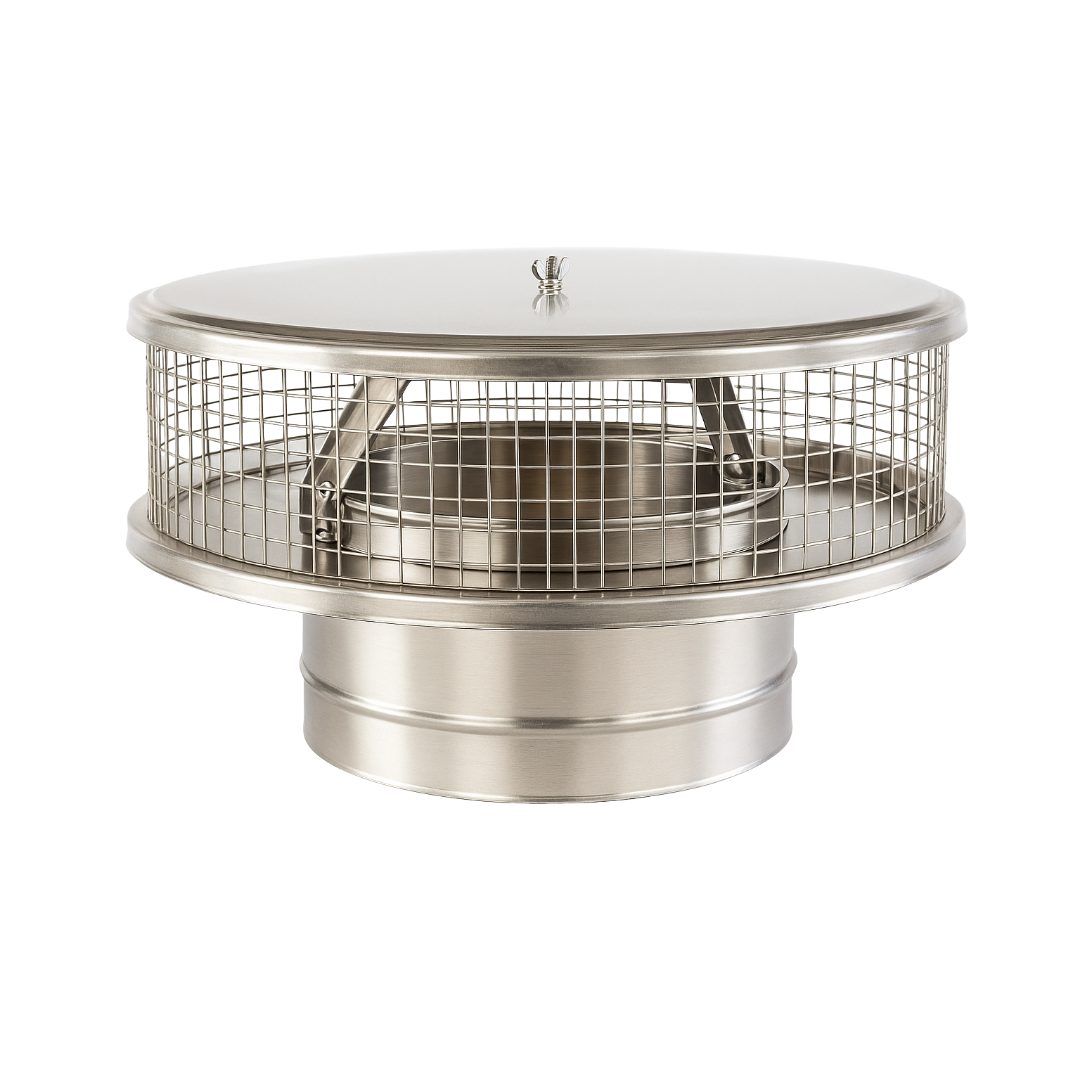
Non Air Cooled Single Wall Chimney Caps
$190.00 – $425.00Price range: $190.00 through $425.00
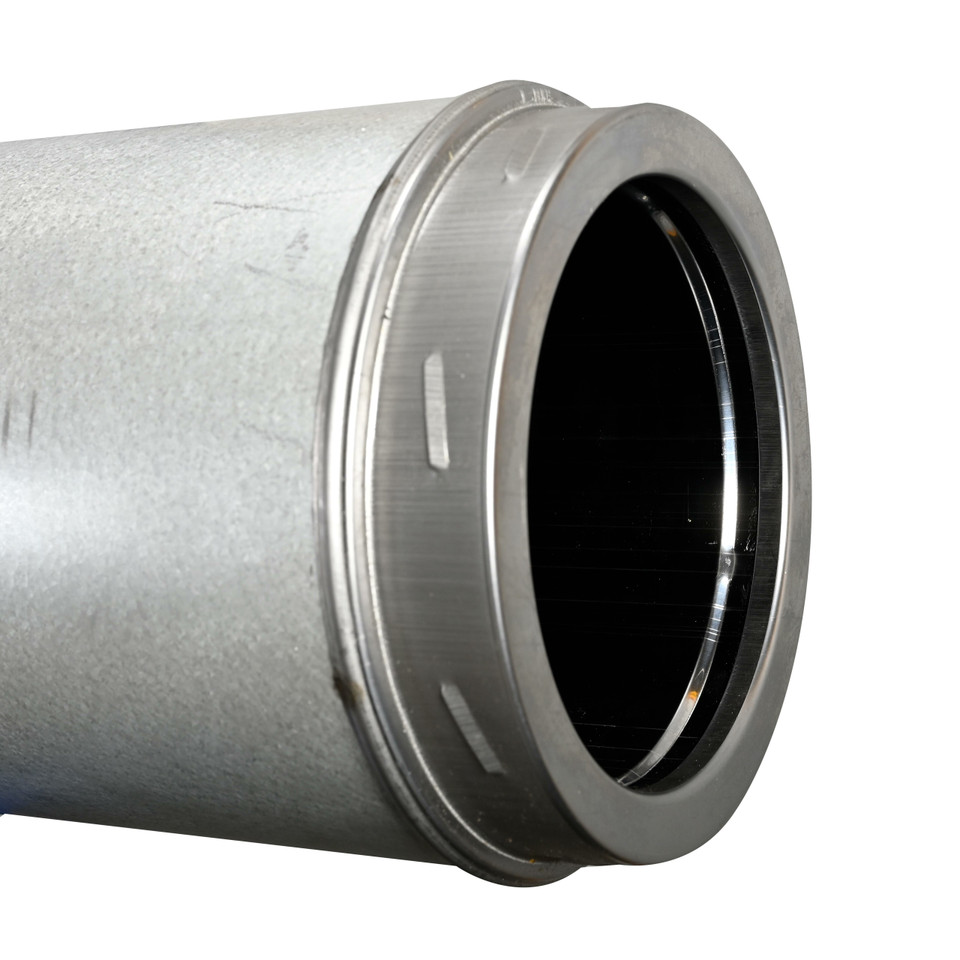
Single-Wall Chimney Caps – Everything You Need to Know
If you have a single-wall metal chimney, adding a chimney cap isn’t just a nice-to-have—it’s a must. These caps do a lot more than just sit on top of your flue. They protect your chimney, boost its performance, and help keep your home safe and comfortable. Let’s dive into what makes single-wall chimney caps so important.
What Makes a Single-Wall Chimney Cap So Useful?
1. Keeps Moisture Out: Rain, snow, and even morning dew can make their way into an uncapped chimney. Over time, this moisture can lead to rust, corrosion, and deterioration of the flue lining or stove pipe. That’s where a chimney cap steps in—it acts like an umbrella for your chimney, keeping the inside dry and extending its life.
2. Stops Animals and Debris: Nobody wants a bird or squirrel making a home in their chimney. It’s not just annoying—it’s dangerous. Nests and debris can block the flue, trap harmful gases, or even cause a fire. A chimney cap with a mesh screen blocks animals, leaves, and twigs from getting inside, keeping everything flowing the way it should.
3. Helps Prevent Roof Fires: When a fire is burning, hot embers can shoot up through the chimney. If they land on your roof or in dry grass nearby, it could spark a fire. A chimney cap acts like a spark guard, catching those stray embers before they become a problem. It’s an easy way to add another layer of safety.
4. Cuts Down on Downdrafts: Ever feel a chilly breeze coming from your fireplace? That’s likely a downdraft. Wind blowing across the chimney opening can push cold air right into your living space. A chimney cap helps block that wind, keeping your home warmer and your energy bills lower.
FAQS
Single-wall (or single-flue) chimney caps are standard chimney caps that are designed for single-wall metal chimneys (chimneys that are made up entirely of a rigid metal tube).
Unlike chimney caps that bolt directly to the flue or chimney crown, these single-wall chimney caps slip right inside the flue’s opening (the interior pipe). To ensure a proper fit, measure the inside diameter of both the center pipe and the outside pipe.
If your home has a single-wall or solid-pack metal chimney, a single-wall chimney cap is a great choice to prevent water penetration, keep animals and debris out, and protect from damage.
These chimney caps are meant for single-wall / solid-pack chimneys only.
To get the correct size, measure the inside diameter of the center pipe and the outside!

Final Thoughts
A single-wall chimney cap may be small, but it plays a big role in keeping your home safe and your chimney in great shape. It helps block moisture, keeps animals and debris out, prevents sparks from flying, and reduces annoying downdrafts. In short—it’s a smart, simple upgrade that gives you peace of mind every time you light a fire.
Single flue Chimney Caps – Everything You Need to Know
If you have a single-wall metal chimney, adding a chimney cap isn’t just a nice-to-have—it’s a must. These caps do a lot more than just sit on top of your flue. They protect your chimney, boost its performance, and help keep your home safe and comfortable. Let’s dive into what makes Single flue Chimney Caps so important.
What Makes a Single flue Chimney Cap So Useful?
1. Keeps Moisture Out: Rain, snow, and even morning dew can make their way into an uncapped chimney. Over time, this moisture can lead to rust, corrosion, and deterioration of the flue lining or stove pipe. That’s where a chimney cap steps in—it acts like an umbrella for your chimney, keeping the inside dry and extending its life.
2. Stops Animals and Debris: Nobody wants a bird or squirrel making a home in their chimney. It’s not just annoying—it’s dangerous. Nests and debris can block the flue, trap harmful gases, or even cause a fire. A chimney cap with a mesh screen blocks animals, leaves, and twigs from getting inside, keeping everything flowing the way it should.
3. Helps Prevent Roof Fires: When a fire is burning, hot embers can shoot up through the chimney. If they land on your roof or in dry grass nearby, it could spark a fire. A chimney cap acts like a spark guard, catching those stray embers before they become a problem. It’s an easy way to add another layer of safety.
4. Cuts Down on Downdrafts: Ever feel a chilly breeze coming from your fireplace? That’s likely a downdraft. Wind blowing across the chimney opening can push cold air right into your living space. A chimney cap helps block that wind, keeping your home warmer and your energy bills lower.
Anatomy of a Single flue Chimney Cap
This illustration shows how each part of a single-wall chimney works together to keep your fireplace safe and efficient:
- Non Air-Cooled Single Wall Chimney Cap: Sits at the very top, shielding the chimney from rain, snow, animals, and debris. It also helps contain sparks, reducing fire hazards.
- Chimney Crown: A protective concrete or metal layer that seals off the top of the chimney and directs water away from the flue opening.
- Flue: The inner passage that carries smoke, gases, and heat safely up and out of your home.
- Chimney Wall: The structural outer shell made of brick or stone that surrounds the flue and provides insulation and strength.
- Smoke Chamber: Positioned just above the firebox, this funnel-like space compresses smoke and gases, guiding them smoothly into the flue.
- Firebox: The main chamber where the fire is built and burns—this is the source of warmth and ambiance in your home.
Each part plays a vital role, and a quality chimney cap ensures the entire system performs at its best.
Tips for Installing Your Chimney Cap
Getting the right fit is key. Single-wall chimney caps are made to slide right into the opening of your chimney pipe. To find the right size, measure the inside diameter of your flue. Some caps use clamps, while others need screws to hold them in place. If you’re unsure, don’t guess—ask a chimney pro for help to avoid any costly mistakes.
Easy Maintenance Goes a Long Way
- Check It Seasonally: Give your cap a quick inspection in the spring and fall. Look for rust, dents, or blockages.
- Keep It Clean: Creosote buildup or trapped debris can block airflow. Clean off anything that’s built up so your chimney can breathe.
- Replace When Needed: A cracked or damaged cap can’t do its job. If you spot damage, swap it out sooner rather than later.
This illustration shows how each part of a Single flue Chimney Cap works together to keep your fireplace safe and efficient:
- Non Air-Cooled Single flue Chimney Cap: Sits at the very top, shielding the chimney from rain, snow, animals, and debris. It also helps contain sparks, reducing fire hazards.
- Chimney Crown: A protective concrete or metal layer that seals off the top of the chimney and directs water away from the flue opening.
- Flue: The inner passage that carries smoke, gases, and heat safely up and out of your home.
- Chimney Wall: The structural outer shell made of brick or stone that surrounds the flue and provides insulation and strength.
- Smoke Chamber: Positioned just above the firebox, this funnel-like space compresses smoke and gases, guiding them smoothly into the flue.
- Firebox: The main chamber where the fire is built and burns—this is the source of warmth and ambiance in your home.
Each part plays a vital role, and a quality chimney cap ensures the entire system performs at its best.
Where Are Round Single-Wall Chimney Caps Used?
A round single-wall chimney cap is commonly installed in two key applications:
Wood Stove Insert inside a masonry chimney
When you have a wood stove insert you will have a stainless steel liner that will run up inside the masonry chimney. The liner will usually protrude above the terracotta flue tile. A top plate will slide over the liner and will attach the flue tile. Next, your chimney cap will slide down inside of the liner.
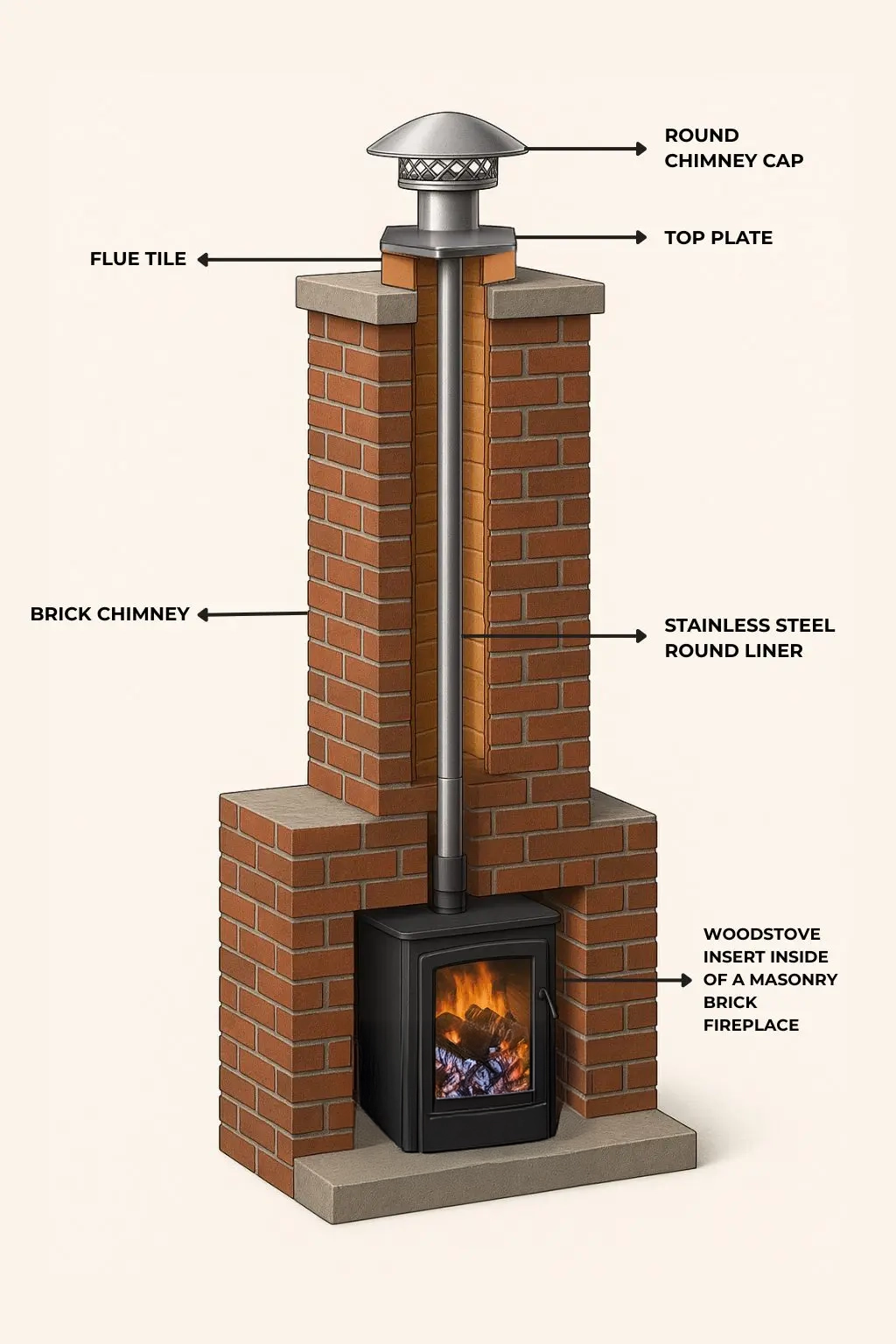

Free Standing Wood Stove
Your free standing wood stove will have stainless steel double wall pipe coming out of the roof. This cap will slip down inside of the double wall pipe.
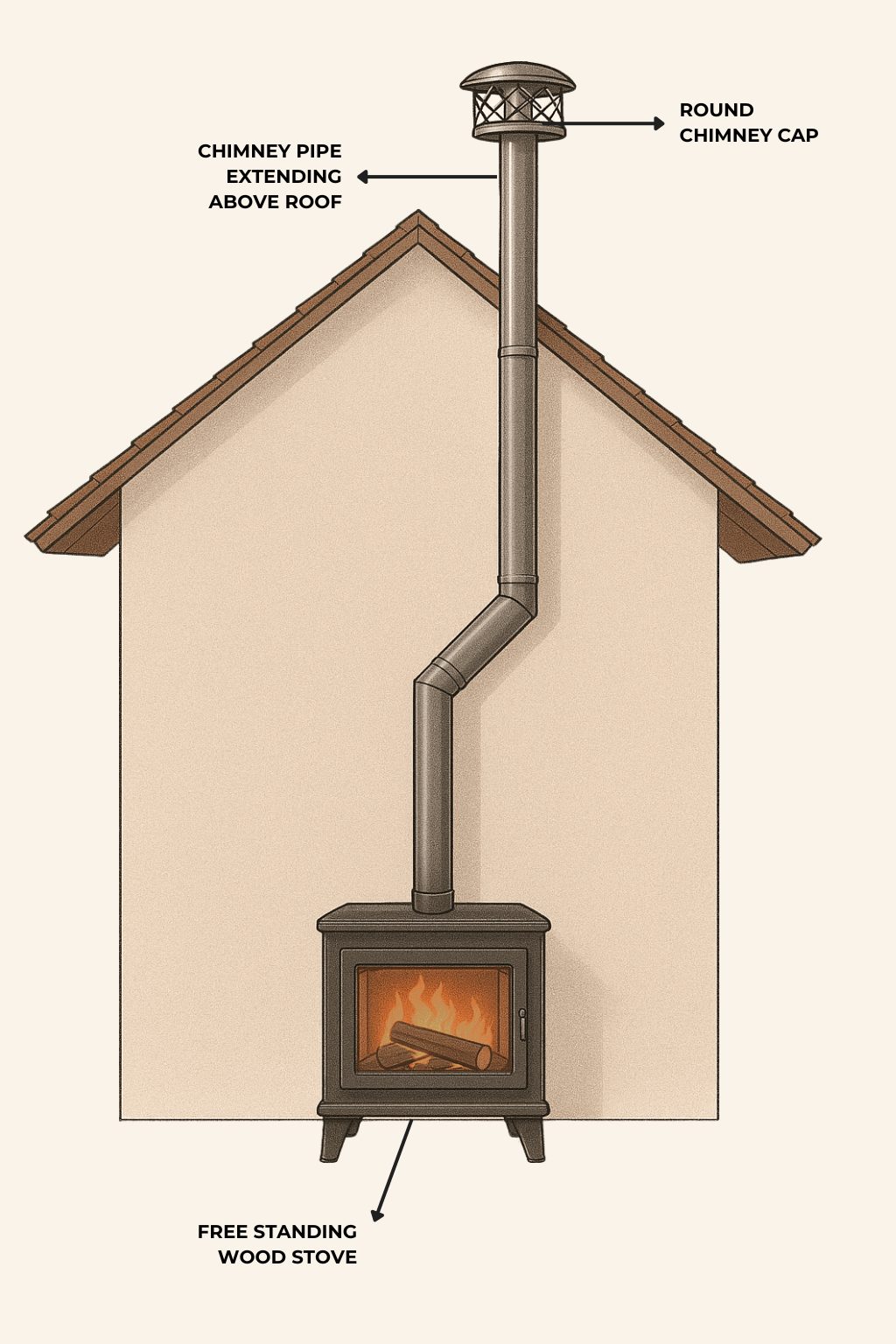
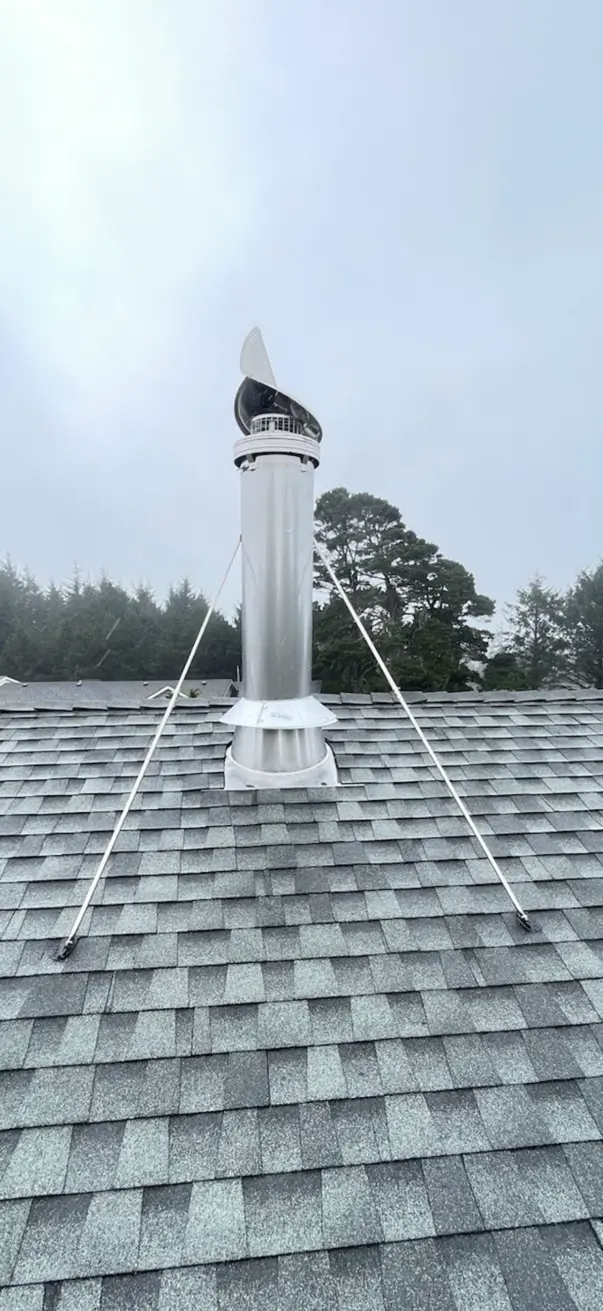
These caps help prevent rain, animals, and debris from entering while allowing proper ventilation.
Tips for Installing Your Single flue Chimney Cap
Getting the right fit is key. Single flue Chimney Cap are made to slide right into the opening of your chimney pipe. To find the right size, measure the inside diameter of your flue. Some caps use clamps, while others need screws to hold them in place. If you’re unsure, don’t guess—ask a chimney pro for help to avoid any costly mistakes.
Easy Maintenance Goes a Long Way
- Check It Seasonally: Give your cap a quick inspection in the spring and fall. Look for rust, dents, or blockages.
- Keep It Clean: Creosote buildup or trapped debris can block airflow. Clean off anything that’s built up so your chimney can breathe.
- Replace When Needed: A cracked or damaged cap can’t do its job. If you spot damage, swap it out sooner rather than later.
Why Single Flue Chimney Caps Are Critical for Your Home's Safety
Single flue chimney caps represent one of the most cost-effective safety investments you can make for your home's heating system. Whether you're dealing with a wood-burning stove, pellet stove, or direct-vent fireplace, a quality single flue chimney cap provides essential protection that extends far beyond simple weather resistance.
Professional Installation vs. DIY: What You Need to Know
Measuring Your Single Flue Chimney Cap Requirements
Getting accurate measurements is crucial for proper single flue chimney cap installation. Here's the professional approach:
Interior Diameter Measurement:
- Use a tape measure to determine the inside diameter of your flue pipe
- Measure at the very top of the chimney opening
- Record measurements in both inches and millimeters for precision
Exterior Considerations:
- Check for any obstructions around the chimney opening
- Measure clearance space for proper cap installation
- Assess wind exposure patterns that might affect cap performance
Advanced Safety Features in Modern Single Flue Chimney Caps
Spark Arrestor Technology
Modern single flue chimney caps incorporate advanced mesh designs that effectively contain sparks while maintaining optimal airflow. The mesh size (typically 1/2 inch openings) meets National Fire Protection Association standards while preventing wildlife intrusion.
Wind-Resistant Design Elements
Quality single flue chimney caps feature aerodynamic designs that actually improve draft performance in windy conditions. Look for caps with:
- Curved wind deflectors
- Multi-directional airflow channels
- Reinforced mounting systems rated for high-wind areas
Regional Building Code Requirements
Different regions have specific requirements for single flue chimney cap installations:
Northern Climate Considerations:
- Ice dam prevention features
- Enhanced corrosion resistance for road salt exposure
- Increased structural ratings for snow load
Wildfire-Prone Areas:
- Mandatory spark arrestor requirements
- Specific mesh sizing regulations
- Enhanced ember containment features
Maintenance Schedule for Maximum Performance
Monthly Visual Inspections
Check your single flue chimney cap monthly during heating season for:
- Visible damage or corrosion
- Debris accumulation in mesh screens
- Proper alignment and secure mounting
Troubleshooting Common Single Flue Chimney Cap Issues
Condensation Problems
If you notice excessive condensation with your new single flue chimney cap:
- Verify proper sizing and installation
- Check for adequate ventilation
- Consider upgrading to an insulated cap design
Draft Performance Issues
Poor draft after single flue chimney cap installation may indicate:
- Incorrect sizing (too restrictive)
- Improper installation height
- Need for a draft-enhancing cap design
Signs It's Time to Replace Your Single Flue Chimney Cap
Replace your cap when you notice:
- Rust penetration through protective coatings
- Damaged or missing mesh sections
- Loose or damaged mounting hardware
- Visible cracks in the cap structure
Environmental Impact and Sustainability
Modern single flue chimney caps contribute to environmental protection by:
- Improving combustion efficiency (reducing emissions)
- Preventing wildlife disruption and habitat damage
- Using recyclable materials in construction
- Extending overall chimney system lifespan
Professional Installation and Maintenance Tips
When selecting single flue chimney caps, consider materials like stainless steel or copper for durability and corrosion resistance. Proper sizing is crucial for optimal performance and safety. Professional installation ensures your chimney cap provides maximum protection while maintaining proper ventilation.
Expert Installation Services: At ChimCare, we offer custom chimney cap fabrication for unique needs, including wind-directional caps perfect for coastal areas. Our certified technicians provide professional installation with lifetime warranties on repairs and products.
Maintenance and Repair: Regular chimney inspections help identify potential issues before they become costly problems. Signs that your chimney cap needs attention include visible rust, loose fittings, or water damage around the chimney area.
For more comprehensive chimney protection strategies, explore our professional chimney sweep services and learn about chimney repair services. You can also find helpful resources on chimney caps and covers and discover our complete chimney services.
FAQS
Single flue Chimney Caps are standard chimney caps that are designed for single-wall metal chimneys (chimneys that are made up entirely of a rigid metal tube).
Unlike chimney caps that bolt directly to the flue or chimney crown, these Single flue Chimney Caps slip right inside the flue’s opening (the interior pipe). To ensure a proper fit, measure the inside diameter of both the center pipe and the outside pipe.
If your home has a single-wall or solid-pack metal chimney, a single-wall chimney cap is a great choice to prevent water penetration, keep animals and debris out, and protect from damage.
These chimney caps are meant for single-flue / solid-pack chimneys only.
To get the correct size, measure the inside diameter of the center pipe and the outside!

Final Thoughts
A Single flue Chimney Caps may be small, but it plays a big role in keeping your home safe and your chimney in great shape. It helps block moisture, keeps animals and debris out, prevents sparks from flying, and reduces annoying downdrafts. In short—it’s a smart, simple upgrade that gives you peace of mind every time you light a fire.

 We Ship Anywhere USA & Canada
We Ship Anywhere USA & Canada



